10 Best Gigabit Routers of 2025 [Top-Rated]

Most wireless routers today claim to handle 1000 Mbps of internet, but not all of them do it efficiently. Also, it’s not just a wired or wireless throughput that matters. The device must be reliable, stable, and powerful to work smoothly.
To find you the best-suited Gigabit WiFi router, I took 17 devices of varying price ranges and used each for various activities, including gaming on a PS5, streaming TVs, browsing the web on multiple devices, and more over the past three months.
After detailed testing, I’ve identified the ones that can handle true Gigabit throughput. So, without further ado, let’s begin!
The below-reviewed options are sorted based on their speeds, coverage, and other features, with the top performer staying on the top and gradually moving to mid-range, and budget yet dependable devices.
Also, I have included options of different types: a stand-alone router, a modem/router combo, and a mesh WiFi system. So, you have plenty of options to choose from based on your preferences, needs, and budget.
Note: You’ll need a gigabit-capable modem to experience this internet speed at its full potential without any dips.
1. Best Overall: TP-Link Archer AXE75
Kicking off my list with TP-Link Archer AXE75, which brings the Wi-Fi 6E standard with an additional 6 GHz band, a tri-band setup, six powerful antennas, a gigabit ethernet setup, and multi-device handling capacity.
With these, the manufacturer has made a considerable leap from its predecessor, TP-Link Archer AX73.
Speeds & Performance
Archer AXE75 boasts a massive throughput capacity of 5400 Mbps, which is split over its tri bands as follows:
| 6 GHz: 2402 Mbps | 5 GHz: 2402 Mbps | 2.4 GHz: 574 Mbps |
On a proximity 20 feet speed test with the Spectrum Internet Gig plan and Motorola MB8611 DOCSIS 3.1 modem, the Archer AXE75 clocked a download speed of 919 Mbps, and an upload speed of 35 Mbps.
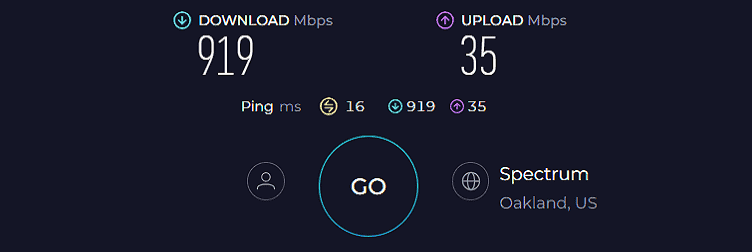
At 40 feet distance, the score of 552 Mbps and 22 Mbps for download and upload surpassed others. With such speeds, I could watch 4K content with my family, attend video calls on Zoom, and complete large downloads in a jiffy.
Aside from that, the gaming performance was also top-notch, with high-end games like Warzone 2.0 and Escape from Tarkov clocking values of 16ms and 95 FPS.
WiFi Coverage & Devices Capacity
Boasting a six-antenna setup, AXE75 is tagged as one of the top picks for 2,500 Sq Ft houses. I performed the test accordingly with the NetSpot, an app that analyzes the signal strength in a particular area.
While it’s quite difficult to put the actual signal range into numbers, the AXE75 roughly covered around 2,200 Sq Ft area.
Moving on, technologies like beamforming, MU-MIMO, and OFDMA work wonders when it comes to handling multiple clients.
I had only 65 devices available, including laptops, gaming consoles, smart TVs, mobile devices, and others, and I received almost four bar signals every time. Trust me on this, you can further add 40-45 devices to the bandwidth.
Security Features
Security-wise, this AXE75 does a great job. With HomeShield basic, you have features like guest access that provides safe and secure internet access for guests and a VPN for remote browsing.
It also has WPA3, which keeps the transferred data encrypted, and a feature that automatically installs the newest firmware version when available.
Besides, it provides strong parental controls, including age-based filters, blocking internet access for individual users, and monitoring how long a device stays online. You can also set time limits and reward your kids with additional time when they complete their homework or help with chores.
Conclusion
The top-tier specs and fast performance for under $200 make TP-Link Archer AXE75 a top-rated gigabit router. It is an ideal choice for those looking to future-proof home networks. Its impressive speeds, coverage, and parental controls stand it apart.
To learn more, check out my dedicated TP-Link AXE75 review.
Pros
- Wi-Fi 6E + Tri-Band support
- Easy to install & manage
- Consistent performance
- Decent wireless coverage
- Great parental controls
Cons
- No multi-gig port
2. Best Runner-Up: Netgear RAX54S
If you’re not interested in the tri-band or WiFi 6E standard, check out the Netgear Nighthawk RAX54S. It features dual-band WiFi 6 and has the same throughput capacity, WiFi range, and port setup as my previous pick.
However, what sets it apart is that Netgear offers a 1-year free subscription to its premium Armor security suite.
Speeds & Performance
The RAX54S is designed for high performance with a maximum throughput capacity of 5400 Mbps, distributing the bands as follows:
| 5 GHz: 4804 Mbps | 2.4 GHz: 574 Mbps |
I used the same Spectrum Gig Internet connection paired with a Motorola MB8611 cable modem and MacBook Pro to determine how well it fares in real life.
Its speed output of 908 Mbps and 33 Mbps for downloads and uploads can be tagged well enough to handle up to 35 bandwidth-hungry clients.
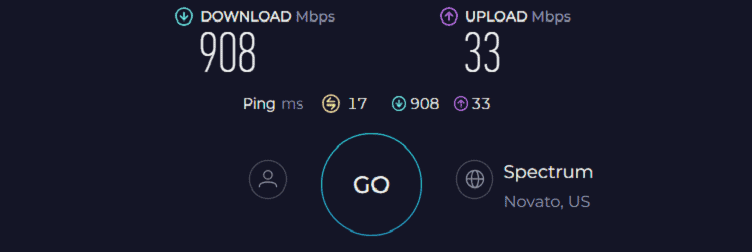
At 40 feet, the speeds dipped as usual, with them clocking at 546 Mbps and 20 Mbps, respectively. Expectedly, the RAX54S passed my saturation test to support 4K streams, listening to podcasts on my tablet, and heavy gaming on my PS5.
All the activities ran skip-free, without jitters, drop-outs, or freezes.
WiFi Coverage & Devices Capacity
The Netgear router achieved decent scores in its range, which was quite expected with its theoretical coverage of 2,500 Sq Ft. Its four-antenna setup performed decent results, with practical numbers faring out at around 2,200 Sq Ft, making it a suitable companion for any two-bed apartment.
However, it stays a bit behind my top pick when it comes to its device-handling ability. The recommended number of connections it can establish is around 35. But what sets it out is the network stability, thanks to support for technologies like MU-MIMO, OFDMA, and beamforming.
Security Features
Security-wise, RAX54S outwits most routers that can handle Gigabit internet. With Netgear Armor, you get many advanced features to secure your home WiFi network. Some notable ones are advanced threat defense, vulnerability assessment & flaw detection, and automatic scans.
Apart from that, you also have access to standard features like guest access, WPA3, VPN, basic parental controls, and auto-firmware updates.
Conclusion
Netgear’s RAX54S combines fast Wi-Fi 6, powerful antennas, and other technologies to emerge as a powerful 1000 Mbps WiFi router. However, it lacks somewhat in device handling capacity, taking it to the runner-up position.
Pros
- Stable network performance
- Netgear Armor security
- Great range & signal quality
- Powerful hardware
- Quick setup & management
Cons
- Middling device handling capacity
3. Best for Gaming: ASUS RT-AX82U
Next, I have the ASUS RT-AX82U, a top gaming router on a budget that establishes a perfect balance between price and features. It encases a dedicated gaming port, mobile boost mode, RGB lights, a powerful chipset, and more for a lag-free gaming experience. But does it live up to a gamer’s expectations? Let’s find out!
Speeds & Performance
RT-AX82U is designed for gaming, with the same speed rating as my previous picks. The 5400 Mbps of throughput is distributed over its dual-band setup, as follows:
| 5 GHz: 2401 Mbps | 2.4 GHz: 574 Mbps |
When testing the RT-AX82U with the Spectrum 1000 Mbps plan, on the 5 GHz mode, at 20 feet distance, I could get speeds of around 894 Mbps for download. At the same time, uploads are valued at 31 Mbps.
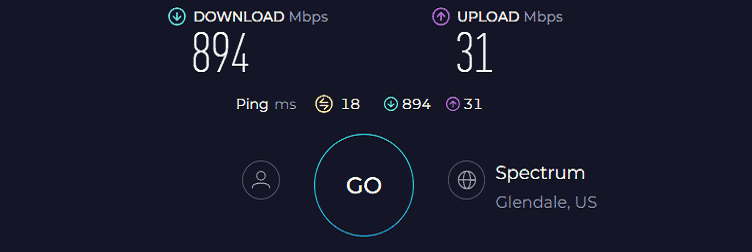
The speeds were enough to play heavy-paced games and stream them live on Twitch. Plus, features like game boost, game port, and adaptive QoS take the gameplay to a whole new level.
I played Destiny 2 on the ASUS TUF laptop and it ran at a 12ms ping value and 77 FPS, with the highest graphic setting.
WiFi Coverage & Devices Capacity
Although it gets a subpar score in this department with a theoretical coverage of 2,000 Sq Ft, which, courtesy of its four antennas, could roughly extend up to 1,700 Sq Ft. The AX82U might perform better than many sub $200 routers.
Going too far over this left me with almost no signals. But there’s an AiMesh support to somewhat compensate for that. You can establish a mesh network by pairing it with another AiMesh-enabled router or extender.
The limitations in the antenna are also reflected in its device handling, as ASUS recommends it for use with 35 clients. Still, I connected 45 devices and they performed well without any major issues. So, it is enough for any residential setup with a gaming console, TVs, laptops, and more.
Security Features
This is where ASUS ousts other gig internet routers on the list. It offers AiProtection with advanced security features without charging any penny.
You’ll find security assessments, firewalls, malicious site blocking, eliminating any infected devices, and others to strengthen your security feature. However, parental controls are too basic for concerned parents.
You can only block pre-defined categories like instant messaging, adult content, and others. Besides, there’s a scheduled access feature to cut off the internet for specific users (kids), but it doesn’t let you block any specific website as such.
Conclusion
Asus RT-AX82U is the best possible gaming router for a 1 Gbps internet connection. Its limited device handling capacity is its sole limitation, but with AiMesh support, it lets you pair with any compatible device and extend it by a few more. Overall, its features are well justified for its price.
For more details, check out the complete review.
Pros
- Gaming-centric features
- Low-latency gaming performance
- Decent WiFi coverage
- Lifetime free security
- Great speeds
Cons
- Middling device handling capacity
4. Best Modem/Router Combo: ARRIS G34
Don’t want the hassle of handling two separate networking devices? Take a look at ARRIS SURFboard G34.
A gigabit modem-router combo is great to think about, and ARRIS SURFboard G34 is your best bet. Aside from a DOCSIS 3.1 modem with 32 x 8 channel bonding, it packs a dual-band Wi-Fi 6 router with great coverage.
Speeds & Performance
With an AX3000 speed rating, the speed split for both bands is as follows:
| 5 GHz: 2401 Mbps | 2.4 GHz: 574 Mbps |
To test it out, I paired it with the Xfinity Gigabit plan, and courtesy of its excellent wireless capabilities, the result was impressive.
At 901 Mbps, downloading a 5 GB file would take less than 10 minutes, while uploads clocked at 31 Mbps. Such speeds should be enough to get your bandwidth-hungry devices, like gaming consoles, laptops, and others, up and running.

In real-world scenarios, the performance was on par with my expectations, as 4K streaming glides through my smart TV, and still, there was more than enough bandwidth left for any of my internet-bound activities.
WiFi Coverage & Devices Capacity
Despite being a 2-in-1 device, it brings a 3,000 Sq Ft range. So I had the trust and installed it in my 2,500 Sq Ft test center. There were a few weak network spots left in the corner, so the numbers stay at around 2,400 Sq Ft in real life, which is on par with the most gigabit wireless routers available.
Barring its coverage, the 2-in-1 device didn’t perform well regarding its device-handling capacity. At a stretch, numbers could go as high as 35, which is not great but good enough for use in apartments.
Security Features
Security is where the device lags majorly. Aside from WPA3 encryption and VPN for keeping the network datasets and your identity secured, there isn’t anything on offer. Tracking online time and pausing the internet are the only features regarding parental controls. So, you might be left wanting more in this department.
Conclusion
All in all, besides being a functional device that delivers more than decent throughput performance and takes the signals far away, ARRIS G34 saves much of your money upfront. It’s a much better upgrade than the ISP-rented gateway. But ARRIS could add more security features.
For more specific information, you may read its full review.
Pros
- DOCSIS 3.1 & Wi-Fi 6
- 32 x 8 channel bonding
- Reliable performance
- Decent signal range
- Easy to install & use
- Affordable price
Cons
- Basic security features
5. Best Gigabit Mesh WiFi: TP-Link Deco X55
Moving on, I have another TP-Link device, Deco X55, which is a go-to mesh WiFi for Gigabit connections. Its standout aspect is a massive coverage of 6,500 Sq Ft, making it the best fit for multi-story large houses and commercial establishments.
Aside from that, its decent port setup and throughput capacity make it a much better device than its previous model, the Deco X50.
Speeds & Performance
Sporting the Wi-Fi 6 standard, Deco X55 boasts a maximum theoretical capacity of 3000 Mbps, with two bands operating simultaneously:
| 5 GHz: 2400 Mbps | 2.4 GHz: 574 Mbps |
Upon testing the mesh system with the Xfinity Gigabit plan, X55 yielded great results, with downloads raking at around 891 Mbps while uploads maxed out at 34 Mbps.
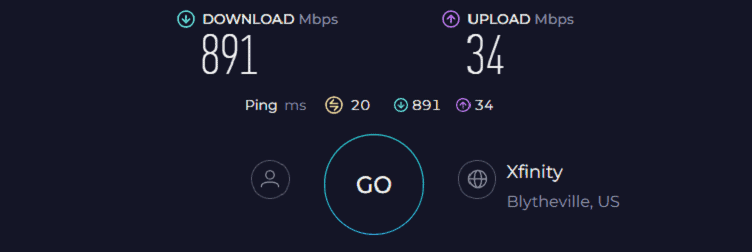
Moving my test system to a 50 feet distance didn’t drop much speed. Thanks to mesh networking tech, I could get 632 Mbps in download and over 23 Mbps in upload.
I could stream 4K movies on Netflix on the first floor without any jitters, and my video meetings could continue pause-free.
WiFi Coverage & Devices Capacity
Being a WiFi mesh router, each node encases two beamforming antennas, and its coverage caps at 6,500 Sq Ft, provided you have three units installed.
I installed it in my 3,700 square foot two-story house, and it provided strong and stable signals throughout the house. The signals were even accessible in a detached garage and the basement. The signal quality is excellent, enabling faster data transmission.
Moving on, its device handling caps at 150, which should be sufficient for any large-sized house. Geared with the latest features like OFDMA and MU-MIMO, the numbers could max out at 85 when streaming and gaming, beyond which the inconsistencies were visible.
Security Features
The free version of the HomeShield is quite enough for any residential setup. With it, users can access some basic yet effective tools like QoS, WPA3, VPN, a home network scanner, and monthly network usage reports.
These should get most of the data transmitted within your devices and network protected from any unwanted agents.
Aside from that, it has some good parental controls like scheduled access, data tracking, and pausing the internet. Without the pro subscription, your kids and network get decent protection from dangerous stuff available online.
Conclusion
TP-Link Deco X55 is a great mesh router that you can use with gigabit internet. It readily eliminates all the issues of dead or weak network spots in a large home. The speeds, security, and other features are also well-balanced.
To learn more about it, you may read my full review of the Deco X55.
Pros
- AI-driven Wi-Fi 6 mesh
- Extensive WiFi coverage
- Great device handling capacity
- Superb throughput speeds
- Easy setup and management
Cons
- No USB port
6. Budget WiFi 6E Router: Tenda RX27 Pro
If you want to get into WiFi 6E for cheap, not many are better options than Tenda RX27 Pro. Its five foldable antennas complement the advanced networking techs to let you extract the most out of your Gigabit plan.
I tested it alongside Tenda RX27, and the performance was much better, courtesy of the upgrades it brings.
Speeds & Performance
Tenda RX27 Pro, with an additional 6 GHz band, boasts a maximum throughput capacity of 5665 Mbps, where the share of each band is as follows:
| 6 GHz: 2402 Mbps | 5 GHz: 2402 Mbps | 2.4 GHz: 861 Mbps |
Over the week of using it as a primary router, RX27 Pro offered truly excellent 5 GHz throughput, which often superseded the 6 GHz throughput. That’s odd when you consider 6 GHz is what makes WiFi 6E stand out.
With AT&T Fiber 1 Gbps as my go-to plan, the Macbook M2 Air (15”), approximately 25 feet away, could access speeds of up to 856 Mbps and 813 Mbps for downloads and uploads, respectively.
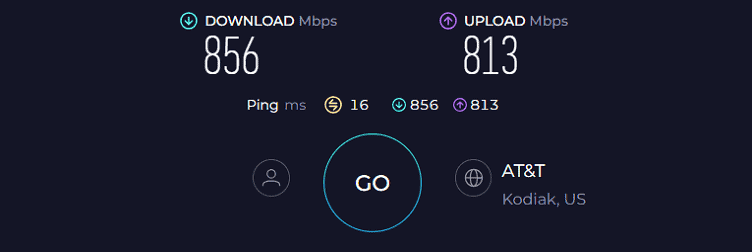
That’s lower than my top 6E router, but the good news, particularly for gamers, is that latency was low at 16ms, besting most out there.
Besides, the distance test (50 feet) got me a respective throughput of 358 Mbps and 321 Mbps for downloads and uploads. Although a speed drop results from the 6 GHz petering out, I could still stream UHD videos and play light online games in a breeze.
WiFi Coverage & Devices Capacity
Tenda RX27 Pro, with its high-gain antenna setup, claims to fit into any three-bedroom apartment with an area of around 2,500 Sq Ft. To test the claims, I installed it centrally at my Nashville test lab, but the routing device missed a few spots.
So, it’s safe to say that RX27 Pro is a smart choice for any 2,200-2,300 Sq Ft space. And with beamforming, you won’t need to worry about stability.
Moving on, the device handled 26 smart devices, including smartphones, laptops, computers, and others. The number isn’t huge, especially when tested alongside my top options, but it should fare well with any family of six to seven people.
Security Features
Security is, however, not on any level with its competitors, as there aren’t any advanced security features on offer: premium or free.
Right out of the box, it entails the basic set of features like WPA3, VPN, access control, guest network, and auto-firmware update, which I reckon is adequate for a residential network setup.
Conclusion
If you’re willing to invest in a future-ready WiFi 6E router on a budget, then investing in the Tenda RX27 Pro certainly offers some significant performance.
The throughput, stability, and, most importantly, latency are much better with the additional band. But, it fails to cut some corners with ports and security features fewer than most.
Pros
- 6 GHz WiFi frequency
- Budget-friendly
- Solid throughput performance
- Simple to set up and manage
- Range is decent
- Ultra-low average latency
Cons
- No advanced security features
7. Best for Home Use: Linksys Hydra 6
If your budget is even lower, and a mid-tier yet reliable WiFi 6 router does the trick for you, then not many are better than Linksys Hydra 6.
The throughput, range, port setup, and performance upgrades it has gotten over its predecessor are adequate to fulfill the bandwidth needs of most households.
Speeds & Performance
Linksys Hydra 6 has a combined throughput capacity of 3000 Mbps, which is split over its two bands as follows:
| 5 GHz: 2401 Mbps | 2.4 GHz: 574 Mbps |
With AT&T Gigabit connection in hand, the numbers it achieved in my speed test weren’t deal-breaking, but great enough. For starters, the 25 feet test clocked a download and upload throughput of 768 Mbps and 721 Mbps, respectively.
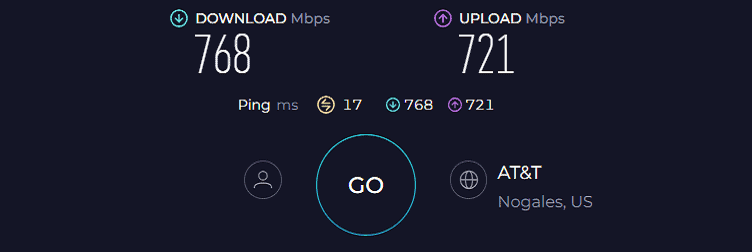
Theoretically, the 750+ download speeds are enough to stream 30 simultaneous 4K video streams.
In practice, the results weren’t far off, as I could stream 4K videos on five devices, play online games on two platforms, attend online classes, and trade stocks, all at the same time. And the audio & video streams came out good and lag-free.
Moving on, the speeds do drop at 50 feet mark, with respective downloads and uploads faring at 315 Mbps and 274 Mbps. That’s still great for most household-based online tasks. Even console games like EA FC24 & League of Legends and mobile games like PUBG & Mobile Legends came out great.
WiFi Coverage & Devices Capacity
Coverage-wise, Hydra 6 stays just behind my previous 6E router, with a capped limit of 2,000 Sq Ft. In reality, the Hydra 6’s powerful antenna setup, coupled with beamforming tech, transmits signals powerful enough to penetrate through thick concrete walls and cover the entirety of my grandpa’s 1,500 Sq Ft house.
The signal density was decent throughout, as revealed on my WiFi analyzer app. Besides, it entails a mesh tech that lets you access undroppable signals over a large space by pairing a mesh tech compatible device.
When it comes to device handling ability, Hydra 6 neared the 20-device mark, and even under this pressure, it showed no signs of buckling, and performance came out good. Here, the heroes are MU-MIMO & OFDMA tech that works to stabilize and concentrate the transmitted signals.
Security Features
The security of Hydra 6 was no different from Tenda RX27 Pro, with the standard set of features like WPA3, VPN, guest network, and access control. These work in tandem to keep the data flowing through the network safe.
Besides, using the Linksys app, you can manually block any website and remove any unwanted devices with the click of a button.
Conclusion
Overall, the features and the corresponding performance Hydra 6 delivers, justify the price it charges. The throughput and range are great for any household network on a Gigabit connection. However, I was disappointed with the security and the number of smart devices it can handle at a time.
Pros
- Dual-band WiFi 6
- Stable throughput
- Decent WiFi range
- Easy to set & use
- Budget-friendly
Cons
- Below-par device handling ability
- Security isn’t advanced
8. Best Security Features: Synology MR2200ac
If security stands atop the requirement list for your 1-gigabit router, then not many are better than Synology MR2200AC. Aside from security, its tri-band support, decent throughput, and plenty of networking tech add up to deliver a satiable performance.
Speeds & Performance
Synology MR2200AC is a tri-band WiFi 5 router with a maximum data transmission ability of 2200 Mbps, with the band-wise speeds as follows:
| 5 GHz (1): 867 Mbps | 5 GHz (2): 867 Mbps | 2.4 GHz: 400 Mbps |
I tested the MR2200AC at my grandpa’s 100-year-old house with thick concrete walls, and the numbers turned out fine.
Its score of 726 Mbps for downloads and 689 Mbps for uploads in my proximity test was faster than most routers in this price bracket.
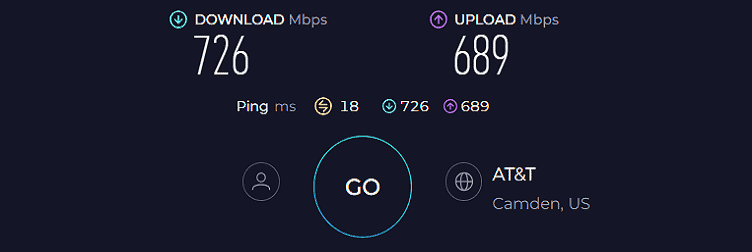
Besides, its distance test remains on the same line with respective download and upload speeds of 256 Mbps & 210 Mbps.
With these speeds, one can easily manage a set of tasks, be it sending emails or UHD streaming, light gaming or online shopping, video conferencing, or others in a breeze. And even after the speed drops, running basic e-tasks wasn’t an issue.
WiFi Coverage & Devices Capacity
The Synology MR2200AC offers coverage for up to 2,000 Sq Ft, which in real life with multiple interferences and obstructions maxed out at 1,600 Sq Ft.
That’s still great for any two-bedroom apartment. But if you have a large house, its mesh tech comes in handy, where you can pair another Synology router to enjoy uninterrupted signals throughout.
But things didn’t look as good in handling multiple devices at a time. I could only keep 15 smart devices online at a time, but courtesy of MU-MIMO, signals didn’t drop once.
Security Features
As stated earlier, security is a key asset for the Synology MR2200ac. Beyond fundamental functionalities like WPA3, VPN, guest networks, and automatic firmware updates, it instills advanced features, including the ability to block malicious IPs and domains, as well as unwanted or infected devices and agents.
This ensures that you can set up your home office confidently, free from concerns about data compromise.
Conclusion
Synology MR2200AC emerges as a highly secure router with several appealing features like robust performance and a high degree of control. Its antennas are powerful enough for most small workspaces and mid-sized apartments, with an additional mesh tech to extend signals over extended distances.
But, speeds lesser than my previous recommendations and instilling only two Ethernet ports are the reason it’s ranked so low in the list.
Pros
- Advanced security tools
- Tri-band operation
- User-friendly app
- Highly customizable
- Decent wireless range
Cons
- Wi-Fi 5 standard
- No USB port
- Below-par devices ability
9. Best for Streaming: ASUS RT-AX5400
If you’re a fan of Asus routers and need a value-for-money piece for your 1000 Mbps connection, take a look at this Asus RT-AX5400.
It takes a lead to Synology MR2200AC in terms of wireless standard, throughput capacity, range, and port setup, so you can expect a much better performance, and doesn’t consume a whole lot of your budget.
Speeds & Performance
The RT-AX5400 is a dual-band WiFi 6 router, which, as the name says, has a maximum throughput capacity of 5400 Mbps. The individual cap on each band is:
| 5 GHz: 4804 Mbps | 2.4 GHz: 574 Mbps |
When it comes to bandwidth, RT-AX5400 performed quite well. I tested the routers both in a “near” location, at 25 feet away, and also at a “far” location, 50 feet away on a higher floor. The test uses the Ookla speed test app with my trusted Dell Xps laptop.
In my first test, the test device managed a download speed of 803 Mbps and an upload speed of 765 Mbps.
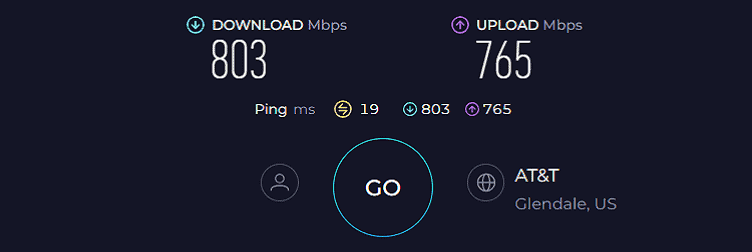
And doubling the distance got the respective speed to 289 Mbps and 256 Mbps for downloads and uploads. Despite decent numbers in distance tests, there were quite a few inconsistencies, which isn’t viable.
But the gaming performance was decent in the near band test, and Overwatch raked a ping value of 22ms and 76 FPS, but there weren’t many pingplotter spikes.
That’s not it. The Asus router further entails a QoS tech for superior gaming & streaming performance, even during peak hours.
WiFi Coverage & Devices Capacity
The RT-AX5400 performed in this aspect as well, and its stipulated 2,500 Sq Ft range stays on par with many high-end routers out there.
At my Nashville test lab, its four-antenna setup could easily cover my client’s 2,100 Sq Ft house in a breeze with stable signals. Stability was never in question, thanks to its beamforming support.
Besides, the accessible bandwidth and technologies such as MU-MIMO and OFDMA facilitate concurrent connections of multiple devices. The maximum number reached is 25, which is well-suited for most residential network configurations.
Security Features
Security is the USP of Asus RT-AX5400 with AiProtection Pro. This lifetime free security software entails plenty of advanced security tools like malware detection & elimination, blocking malicious apps, websites, and agents.
Alongside, its features like two-way IPS and DDoS protection add a cherry on top, making your browsing experience more secure.
Conclusion
Overall, the Asus RT-AX5400 stands out as a commendable mid-range router ideal for small to medium-sized homes with moderate internet needs.
Its Quality of Service (QoS) guarantees seamless gaming and streaming, and the incorporation of AiProtection Pro introduces robust security features, positioning it among the leading options for free security software.
But its distance speeds are a tad inconsistency, the reason why it’s ranked at the penultimate position.
Pros
- Wi-Fi 6 support
- Great speeds
- Adaptive QoS for prioritization
- Lifetime AiProtection Pro
- Easy to install and configure
- Decent coverage range
Cons
- Distance speeds are inconsistent
10. Cheapest Option: TP-Link Archer AX21
Last but not least, I present you with a cheap yet dependable Gig internet router, TP-Link Archer AX21. With WiFi 6 standard, Quad-Core processor, and powerful antennas, it delivers a good throughput and strong signal strength. Besides, I tested it alongside Archer AX12, and AX21 superseded it in most respects.
Speeds & Performance
TP-Link AX21 can hit a maximum theoretical data rate of 1800 Mbps, with the individual capacity of dual-band setup as follows:
| 5 GHz: 1201 Mbps | 2.4 GHz: 574 Mbps |
With the AT&T Gigabit plan at bay, I can say that I was pleasantly surprised with what AX21 has to deliver.
From a distance of 25 feet away, my test device clocked a download speed of 701 Mbps. Meanwhile, the upload speeds maxed out at 672 Mbps. For a budget piece, that’s lightning fast.
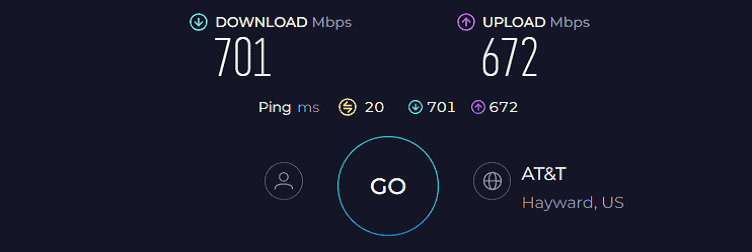
Moving on, the Archer AX21 fared pretty well in my distance test. At 50 feet, it managed a download and upload speed of 189 Mbps and 154 Mbps, respectively. That’s even faster than more expensive routers out there.
With the available speeds, especially at close distances, you can stream a cracking 27 UHD Netflix movies simultaneously, if needed. Besides, its QoS tech allows for an uninterrupted streaming and gaming experience even during peak hours.
WiFi Coverage & Devices Capacity
Barring a decent performance in my throughput test, AX21 surprised me in this aspect as well. Upholding four powerful antennas, it managed to sustain a signal to an area as large as 2,200 Sq Ft, or the size of a two-bedroom apartment. Besides, it went for cleaners concerning stability, thanks to the beamforming tech.
The routing unit, with its OneMesh tech, allows you to add mesh satellites and seamlessly increase the overall range. That’s great for a budget piece.
Moving on, the available bandwidth and MU-MIMO tech managed to handle up to 21 smart connections at once. These include a mixed set of devices like smartphones, computers, laptops, smart lights, and others.
Security Features
TP-Link is hell-bent on the security of its users and provides you access to a set of basic yet effective features like SPI firewall, WPA3, VPN, guest network, and access control. These work in tandem to secure the data transmitted through a network.
But for advanced features like malware elimination, you must pay a minimal monthly or yearly subscription.
Conclusion
All said and done, TP-Link Archer AX21 is one of the top budget offerings. Although it lacks 160 MHz channel transmissions or TP-Link’s advanced parental controls, but is a capable router to handle most of your household tasks in a breeze. Besides, its signal range is great for a budget piece.
Pros
- Great and stable throughput
- Decent range and mesh ready
- Decent security features
- QoS for traffic prioritization
- Handles 20+ smart connections
Cons
- Doesn’t support 160MHz channels
- Parental controls are basic
Frequently Asked Questions
How many devices can a Gigabit router handle?
A router capable of handling 1000 Mbps internet should get most of your smart device setup covered. As far as my tests go, these devices handle at least 25 devices simultaneously, and the numbers might increase from one to another.
Is 1 gig internet good for gaming?
1 Gig internet is much faster than you need for your online gaming. Many online games like Fortnite, Fall Guys, and League of Legends need well under 100 Mbps. The thing that matters the most while gaming is ping value and potential latency. For high-speed gaming, your ping value must stay well below 20ms.
What to look for in a 1000 Mbps WiFi router?
Look for features like the dual or tri-band, processing setup, connection capacity, WiFi coverage, and ports. The more, the better. Keeping these in mind, get an ideal companion for your Gigabit internet.
Verdict
We all need a speedy connection, whether playing video games, streaming media, or balancing multiple devices. And to accommodate that, you need an efficient router.
I hope the curated list helped you make an informed choice and get you a router that gets most of your internet-bound tasks within a click. But if you still are scratching your head, here are my final suggestions:
- If the best is what you need and you care less about the budget, TP-Link Archer AXE75 is your go-to option.
- If you’re a gamer who needs a reliable router for low-ping gaming, get the ASUS RT-AX82U.
- If budget is a bit of a concern, but you don’t want to compromise much on the features, then look at the Linksys Hydra 6.
Thanks for reading!
